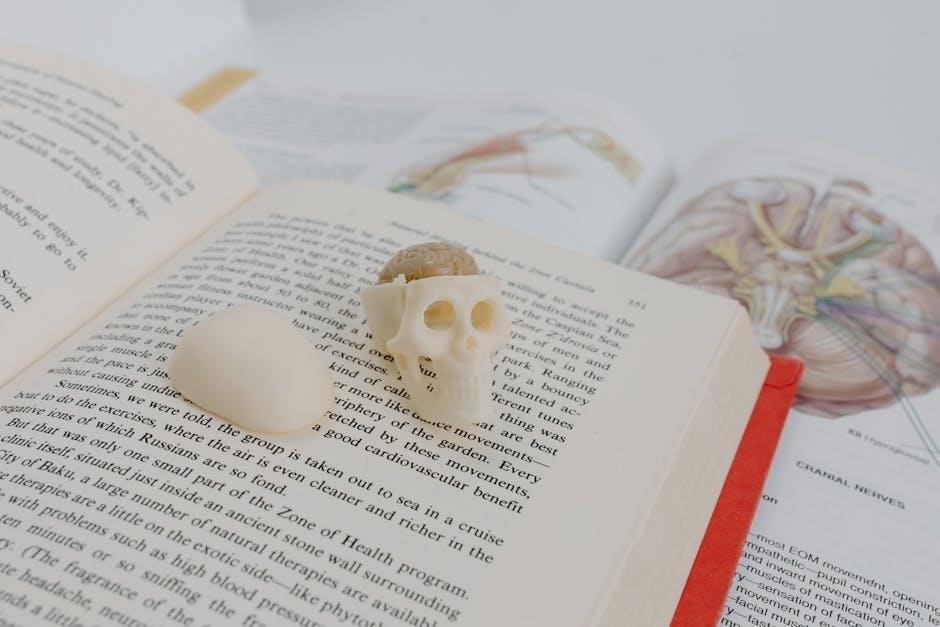This study guide covers foundational concepts in AP Biology, including atomic structure, chemical bonds, properties of water, biomolecules, enzymes, pH, thermodynamics, and cell structure. It provides detailed notes and practice questions to help students prepare for exams and the AP Biology test.

Atomic Structure
Atomic structure introduces the basics of matter, focusing on protons, neutrons, and electrons. Protons and neutrons reside in the nucleus, while electrons orbit it. The atomic number (protons) defines an element, and the mass number includes neutrons. Isotopes vary by neutron count, affecting atomic mass.
1.1 Protons, Neutrons, and Electrons
Protons, neutrons, and electrons are the fundamental components of an atom. Protons and neutrons are located in the nucleus, with protons determining the element’s identity through the atomic number. Electrons orbit the nucleus in energy levels or shells. The number of electrons equals the number of protons in a neutral atom, ensuring charge balance. Understanding these particles is crucial for comprehending chemical properties and interactions in biological systems. This section also explores isotopes, which differ in neutron number, affecting atomic mass but not chemical behavior. Mastery of this topic is essential for analyzing periodic trends and chemical bonding in subsequent units.
1.2 Electron Configuration
Electron configuration describes the distribution of electrons in an atom’s orbitals, following specific rules to ensure stability. The Aufbau principle states that electrons fill lower energy levels first. The Pauli exclusion principle dictates that no two electrons can occupy the same orbital with the same spin. Hund’s rule explains that electrons will spread out in degenerate orbitals before pairing. Understanding electron configuration is vital for predicting chemical behavior and bonding patterns. In biological systems, electron configuration influences molecular properties, such as reactivity and solubility. This knowledge is foundational for topics like ionic and covalent bonding, as well as enzyme function and biomolecule interactions. Mastery of electron configuration enables students to analyze periodic trends and understand the chemical basis of life.
1.3 Periodic Trends
Periodic trends describe the predictable patterns in atomic properties across the periodic table. Key trends include atomic radius, electronegativity, and ionization energy. Atomic radius decreases across a period due to increasing nuclear charge but increases down a group as electron shells are added. Electronegativity, the ability to attract electrons, generally increases across a period and decreases down a group. Ionization energy follows a similar pattern, rising across a period and falling down a group, with exceptions for elements like hydrogen and helium. These trends are crucial for understanding chemical behavior and bonding, as they predict how elements interact. In biology, periodic trends help explain the roles of elements in living systems, such as the high electronegativity of oxygen and nitrogen in biomolecules. Mastery of these trends is essential for analyzing chemical reactions and understanding the periodicity of element properties, which underpin many biological processes and molecular interactions.
1.4 Isotopes and Radioactivity
Isotopes are atoms of the same element with differing numbers of neutrons, leading to varying physical properties while retaining the same chemical behavior. In biology, isotopes are used as tracers, such as carbon-14 in radiocarbon dating, to study processes like nutrient cycling and metabolic pathways. Radioactivity occurs when unstable isotopes undergo decay, emitting radiation to achieve stability. Types of radioactive decay include alpha, beta, and gamma decay, each releasing energy in different forms. Understanding isotopes and radioactivity is crucial for applications in medicine, ecology, and molecular biology, where they are used for imaging, cancer treatment, and studying DNA structure. The half-life of isotopes, the time it takes for half the atoms in a sample to decay, is a key concept in determining the age of biological samples and understanding evolutionary timelines.

Chemical Bonds and Interactions
Chemical bonds and interactions are essential for forming molecules and maintaining biological structures. Ionic bonds involve electron transfer, while covalent bonds share electrons between atoms. Hydrogen bonding, a weaker interaction, significantly influences water’s properties and biomolecule stability, playing a crucial role in biology.
2.1 Ionic Bonds
2.2 Covalent Bonds
2.3 Hydrogen Bonding
Hydrogen bonding is a type of intermolecular force that arises from the attraction between a hydrogen atom covalently bonded to a highly electronegative atom (such as oxygen, nitrogen, or fluorine) and another electronegative atom bearing lone pairs of electrons. This interaction is weaker than ionic or covalent bonds but plays a critical role in the properties of water and biological molecules. Hydrogen bonding is responsible for water’s high surface tension, cohesion, and boiling point, making it a universal solvent. In biological systems, hydrogen bonds stabilize the structure of DNA’s double helix, hold strands of RNA together, and contribute to the secondary, tertiary, and quaternary structures of proteins. Additionally, hydrogen bonding facilitates interactions between enzymes and substrates, as well as between antibodies and antigens. Understanding hydrogen bonding is essential for appreciating the functional properties of biomolecules and their interactions in biological systems.

Properties of Water
Water’s unique properties include high surface tension, cohesion, and solvent capability. These properties stem from hydrogen bonding and polarity, enabling water to dissolve salts, minerals, and organic compounds, making it a universal solvent essential for biological processes.
3.1 Surface Tension and Cohesion
Water exhibits high surface tension due to strong hydrogen bonding between its molecules, creating a “skin” at the water’s surface. This property allows insects to walk on water and helps maintain water droplet shape. Cohesion, the attraction between water molecules, is crucial for capillary action, enabling water transport in plants. These properties are essential for biological processes and maintaining aquatic ecosystems. Surface tension also reduces evaporation, preserving water in environments. Cohesion plays a key role in maintaining water’s structure and flow, vital for life. These characteristics are unique to water and contribute to its universal role in biological systems. Understanding surface tension and cohesion is fundamental for studying water’s behavior in living organisms and ecological systems.
3.2 Water as a Universal Solvent
Water is often called the “universal solvent” due to its exceptional ability to dissolve a wide variety of substances. This arises from its polar nature, with oxygen’s negative charge and hydrogen’s positive charge allowing it to interact with and break the bonds of numerous compounds. In biological systems, water serves as the medium for biochemical reactions, facilitating the transport of nutrients and waste products. Its high dielectric constant enables water to stabilize ions and polar molecules, making it an ideal solvent for cells. Additionally, water’s solvent properties contribute to maintaining proper pH levels, essential for enzyme function and cellular processes. This unique characteristic ensures water’s critical role in sustaining life and enabling biochemical interactions. Understanding water’s solvent properties is vital for comprehending its function in biological systems and its importance in maintaining life.

Biomolecules
Biomolecules are the essential organic compounds that form the basis of life. They include carbohydrates, lipids, proteins, and nucleic acids. Carbohydrates, such as glucose, serve as primary energy sources and structural components in cells. Lipids, including fats and phospholipids, are crucial for energy storage, cell membrane formation, and signaling. Proteins are versatile molecules that perform a wide range of functions, from catalyzing reactions as enzymes to regulating cell processes. Nucleic acids, DNA and RNA, store and transmit genetic information, ensuring the continuity of life. These biomolecules interact within cells to maintain homeostasis and support life’s complexity. Understanding their structures, functions, and interactions is fundamental to studying biology. This section delves into the composition and roles of each biomolecule, providing a comprehensive foundation for advanced topics in AP Biology. By mastering biomolecules, students gain insights into the molecular basis of life and its processes.
Enzymes
Enzymes are biological catalysts that accelerate chemical reactions in living organisms. They are typically proteins, though some RNA molecules can also act as enzymes. Enzymes function by lowering the activation energy required for a reaction, making processes like metabolism and DNA replication efficient. Each enzyme has an active site, a specific region that binds to substrates, ensuring precision in catalysis. The induced fit model explains how enzymes adjust their shape to bind substrates effectively. Factors such as temperature, pH, and substrate concentration influence enzyme activity. At optimal levels, enzymes function efficiently, but extreme conditions can denature them. Inhibitors, which can be competitive or noncompetitive, reduce enzyme activity by interfering with substrate binding or altering the enzyme’s structure. Understanding enzymes is crucial for grasping biological processes, as they regulate pathways essential for life. This section explores enzyme kinetics, regulation, and their role in maintaining cellular homeostasis, providing foundational knowledge for advanced topics in AP Biology.
pH and pKa
pH is a measure of the hydrogen ion concentration in a solution, indicating its acidity or basicity. A pH of 7 is neutral, while values below 7 are acidic and above 7 are basic. The pKa, or acid dissociation constant, represents the pH at which an acid is 50% dissociated. Understanding the relationship between pH and pKa is crucial in biology, as it influences enzyme activity, protein structure, and membrane function. Enzymes typically operate optimally within a narrow pH range, and deviations can denature them. The pKa of ionizable groups in amino acids determines the overall charge of proteins at different pH levels, affecting their function. Buffers, such as bicarbonate and phosphate systems, help maintain pH homeostasis in organisms. The Henderson-Hasselbalch equation, pH = pKa + log([A-]/[HA]), is a key tool for calculating pH when the concentrations of acid and conjugate base are known. This section explores how pH and pKa regulate biological processes and maintain stability in living systems.

Thermodynamics in Biology
Thermodynamics in biology explores how energy flows and transformations govern life processes. The first law states that energy cannot be created or destroyed, only converted between forms. The second law introduces entropy, a measure of disorder, emphasizing that systems tend toward disorder over time. In biological systems, energy is often stored in chemical bonds, such as ATP, which powers cellular activities. Enthalpy (H) and Gibbs free energy (ΔG) are critical concepts: ΔG determines the spontaneity of a reaction, with negative ΔG indicating a favorable process. Biological systems maintain order by increasing the entropy of their surroundings, often through heat dissipation. Key biological processes, such as photosynthesis and cellular respiration, rely on thermodynamic principles to convert energy between forms. Understanding these principles is essential for analyzing metabolic pathways, enzyme kinetics, and the efficiency of energy transfer in living organisms. This section delves into how thermodynamics shapes the energy transactions that sustain life and enable cellular function.

Cell Structure Overview
The cell is the smallest unit of life, capable of reproducing itself and maintaining homeostasis. All cells share common features, such as a plasma membrane, cytoplasm, and genetic material. The plasma membrane is a phospholipid bilayer that regulates the movement of materials in and out of the cell, while cytoplasm provides a medium for metabolic processes. Eukaryotic cells contain membrane-bound organelles like the nucleus, mitochondria, and endoplasmic reticulum, which specialize in functions such as DNA storage, energy production, and protein synthesis. Prokaryotic cells lack these organelles and have a simpler structure. The nucleus houses most of the cell’s genetic material, and the mitochondria are often referred to as the “powerhouses” of eukaryotic cells. Other key structures include ribosomes, where protein synthesis occurs, and the cytoskeleton, which provides structural support and aids in cell movement. Understanding cell structure is fundamental to analyzing cellular function and the biological processes that sustain life.